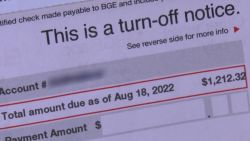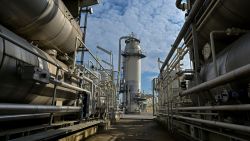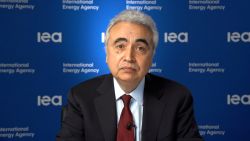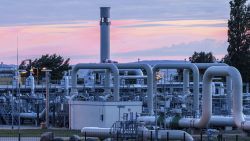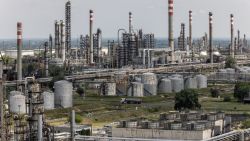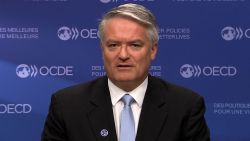By many measures, the European Union has succeeded in its goal to break its dependence on Russia’s natural gas, avoiding the fuel shortages and blackouts many had feared at the height of last winter’s energy crisis.
The bloc of 27 nations, heavily dependent on gas imports, once relied on Russia for around half of those inflows. But it has boosted imports of piped and liquefied natural gas (LNG) from elsewhere, fast-tracked the approval and construction of LNG infrastructure, and urged its citizens to cut their energy consumption — and all in the 20 months since Moscow launched its full-scale invasion of Ukraine.
It has passed at least one test with flying colors, earning a score of 99% — that’s how full the bloc’s gas storage facilities were Thursday, which is comfortably above the 90% level the EU’s executive body instructed member states to reach by the start of November, when the heating season begins in earnest.
Longer-term trends also mean that Europe’s gas needs are gradually declining. The International Energy Agency (IEA) said last month that it expected demand for the fuel in “mature markets” — comprising Europe, North America and parts of Asia — to fall 1% every year till the end of 2026 as countries expand their renewable energy sectors and became more energy-efficient.
But while gas shortages are unlikely in Europe this winter, the price of the fuel remains a worry.
Prices on commodity markets in the region have shot up 28% in the past month. And even before that surge, they were still almost double their historical average for the time of year.

“The increase in LNG supply was not enough to offset the sharp declines in deliveries of pipeline gas from Russia to Europe,” the IEA said in October. “As such, the risk of price volatility, particularly in the event of a cold winter, is cause for concern.”
That volatility could mean more upward moves in European prices, and reflects the fact that Europe now has fewer options to procure more gas should it need to. It may need more of the fuel if the coming winter is much colder than anticipated, or if Russia — which still supplies gas via pipelines to a handful of European countries, including Hungary and Austria — cuts off all piped exports, according to Moody’s.
In Europe’s tight market, traders are “hypersensitive,” says Jack Sharples, senior research fellow at the Oxford Institute of Energy Studies, who notes that some of the bloc’s biggest suppliers of piped gas such as Norway, Azerbaijan and Algeria don’t have much spare capacity.
“Anything that might suggest an uptick in demand or a curtailment of supply is going to send prices jumping,” he told CNN.
According to Moody’s, prices for the fuel will remain higher in Europe than elsewhere.
High gas prices have presented a particular economic headwind for some European countries — notably Germany, the region’s biggest economy — because of their reliance on energy-intensive industries.
Escalating conflict?
The price of Europe’s benchmark gas contract has jumped from €36 ($38) to €47 ($50) per megawatt hour since October 5, just before a confluence of geopolitical risks began to shake traders’ confidence.
On October 7, Palestinian militant group Hamas launched a brutal assault on Israel, killing more than 1,400 people, most of them civilians. Israel has responded by bombarding the Hamas-controlled Gaza Strip from the air, and later sending ground troops into the enclave.
The fighting has fueled concerns that conflict could spread throughout the region and affect the Strait of Hormuz, a vital waterway used for exporting LNG.
According to S&P Global, about one-fifth of global LNG supply travels through the channel on Iran’s south coast.
The Hamas attack has also led to energy giant Chevron (CVX) shuttering its Tamar gas field off Israel’s south coast, which exports the fuel to neighbors Jordan and Egypt.
A drop in Israeli gas flows to Cairo — which processes some of its gas stocks into LNG for shipping abroad — may mean fewer, or no, Egyptian LNG exports this winter, analysts tell CNN.
A hair-trigger market
On the weekend Hamas attacked Israel, Finland’s gas transmission operator also said it had temporarily shut a pipeline connecting the country with Estonia over a suspected leak. Soon after, the operator said the pipeline would remain closed for at least five months and news also emerged that workers at two major LNG facilities in Australia were planning to go on strike.
In a less jittery market, neither incident may have had the effect it did, helping boost European gas prices by more than 40% over the course of a single week.

Finnish authorities have launched a criminal investigation into whether the pipeline was deliberately damaged, resurfacing concerns about the vulnerability of Europe’s critical infrastructure a little over a year after a series of explosions rocked the Nord Steam 1 pipeline — once the main artery funneling Russian gas to the region.
As for the planned strike over pay and conditions at Chevron’s Australian LNG facilities, which was eventually called off, it offers a “textbook example” of the interconnectedness of the global gas market, according to Simone Tagliapietra, a senior fellow at think tank Bruegel.
“These strikes do not affect Europe directly,” he told CNN. “But it affects the global LNG market overall, and… therefore European prices jump as a result of something that happens in Australia.”
Europe is “safe for the winter,” he said, but its reliance on LNG for additional supply means that “if anything happens” prices could surge.
Bill Weatherburn, a commodities economist at Capital Economics, agrees.
He wrote in a note last week that Europe’s reliance on LNG had recently pushed some countries in the region, including France and Italy, to sign 27-year contracts with Qatar for the fuel, exactly the type of long-term LNG import agreements “the bloc has eschewed in the past.”
A ‘flood’ of LNG
Still, Europe can breathe easier this winter and may be in a much better position this time next year.
Gas prices are down 86% from their all-time high of €339 ($357) per megawatt hour, hit in August 2022 when EU member states were scrambling to secure enough gas ahead of their first winter without the usual bounty of Russian exports.
And, in the next few years, the bloc can anticipate a “wave” of new LNG supply to make its way to the global market, according to the IEA.
The agency said in its annual World Energy Outlook, published last week, that it expected 250 billion cubic meters of new liquefaction capacity — that is, the process of cooling natural gas into a liquid state for transportation — to come online by 2030, equal to almost half of the current global supply of LNG.

A particularly large upswing is expected between 2025 and 2027, the IEA said.
Similarly, Weatherburn wrote that, from early 2024, “a veritable flood of LNG supply is scheduled to begin to flow into global markets.” “This will weigh heavily on both European natural gas and Asian LNG prices,” he added.
The next two years will see the completion of work on several LNG export terminals in the United States and on the first phase of the expansion of a key offshore gas field in Qatar, he said.
Together, these milestones should push European gas prices down to €30 ($32) per megawatt hour by the end of next year, Weatherburn added.



